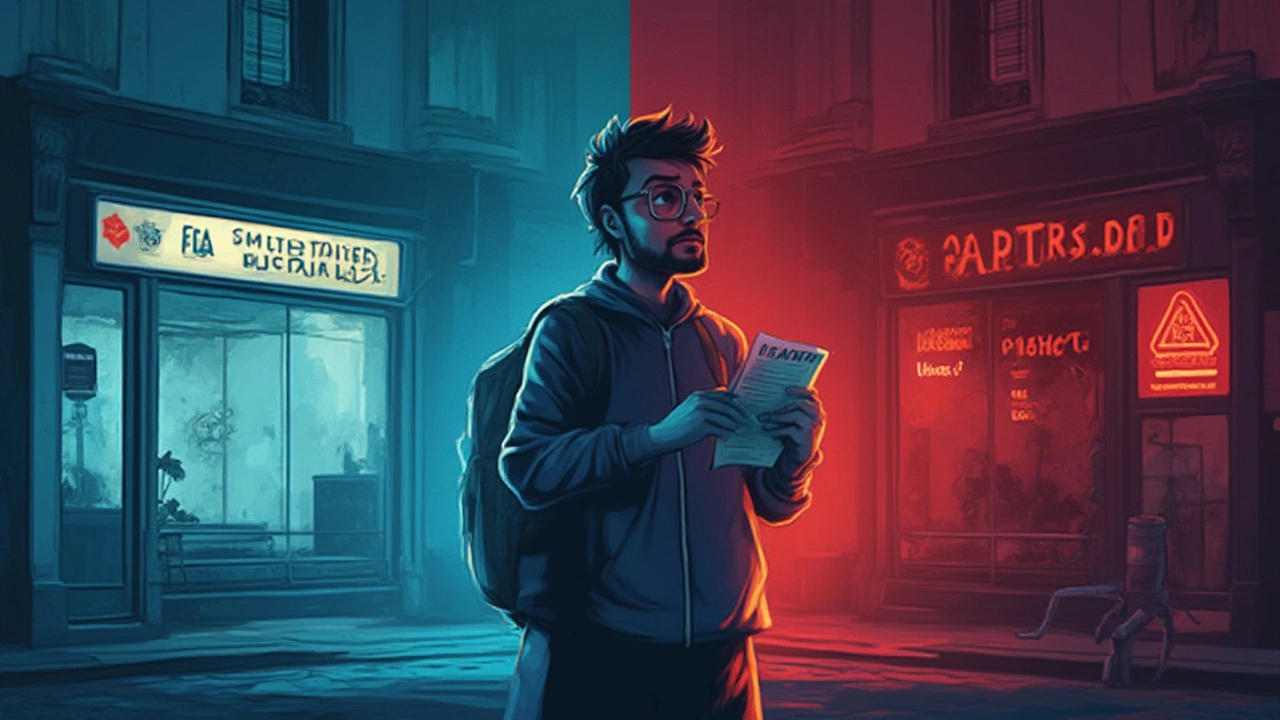Ever thought about how crazy it would be to hand over your financial secrets to just anyone? Getting a personal loan can feel a lot like that. Some lenders are reliable; others, not so much. One wrong move and you might end up paying more than you bargained for—or worse, tangled up with scammers. In 2025, the loan landscape is busier and riskier than ever, packed with offers that sometimes sound too good to be true. So, how do you pick a place that actually has your back?
Why Loan Safety Should Be Your Top Priority
Your financial well-being is too precious to gamble with. You could walk into a flashy lender's office or fill out an online application in ten minutes, but here's the catch: safety isn't guaranteed just because a place looks legit. Some lenders sport smooth websites and polished ad campaigns but hide high fees or questionable terms in microscopic print. Others fish for your info with the sole purpose of making off with it—identity theft is up nearly 25% since 2020, and personal loan scams are a big reason why.
Many borrowers trust their banks or well-known credit unions because these places are usually regulated by the government. If something goes sideways, you have a way to complain, get help, or even recover your money. Big names in personal lending—think LightStream, Marcus by Goldman Sachs, and SoFi—have strict security measures and transparent lending terms. These institutions have been around a while, and their reputations matter. But even among reputable names, always check for government registration. In the US, legitimate lenders must be registered in your state, so check your state regulator's website. UK borrowers, meanwhile, should look for FCA registration on the lender’s site. This step slashes your risk of falling into a trap.
Bad actors have gotten savvier with deep-fake websites and fake reviews, so it’s a must to read real customer experiences on platforms like Trustpilot or Google. And don’t underestimate the fine print—hidden clauses add up to serious losses. If you can't clearly understand what you're signing, you should be suspicious. With bank loans, you usually get a three-day cooling-off period, so if the lender seems eager to have you sign immediately, that’s a red flag. Transparent communication, mandatory state or federal licenses, and a clear, accessible complaints process are all signs you’re dealing with a safe lender.
Prioritizing safety isn't just about avoiding outright crooks—it's about dodging sneaky fees, ballooning interest rates, and other financial landmines. So, while speed and convenience matter, they should always come second to your financial security. If something feels off, it probably is. Take a deep breath, look for those safety signals, and remember—this is your money. Don’t give anyone a shortcut to your trust.
Banks vs. Credit Unions vs. Online Lenders: Who Can You Trust?
When it comes to borrowing, you’re looking at three main players—traditional banks, credit unions, and online lenders. Each type has its perks and pitfalls, so let’s pull back the curtain and see which is the safest bet for you.
Banks often feel like the default choice for personal loans, especially if you already have an account. They tend to offer competitive interest rates and robust customer support. Security is built into their DNA—just look at all those security questions every time you log in. With FDIC insurance in the US, your data and accounts get extra protection. Plus, you can physically walk into a branch if trouble pops up. But banks are also known for stricter eligibility requirements. They look closely at your credit score, income, and repayment history. Don’t expect much wiggle room if your financial track record is bumpy.
Credit unions are a favorite for those who love a community touch. Owned by their members, these not-for-profits often hand out lower rates and more flexible terms. The National Credit Union Administration (NCUA) insures your funds up to $250,000. These organizations go out of their way to build long-term relationships, which can mean more understanding if things get rough. The catch? You usually need to join the union by living in a certain area, working a specific job, or belonging to a particular group. There might be fewer branches and less flashy tech. But if personal touch and slightly better rates are your priority, they’re worth a look.
Online lenders have shaken up the market in the last decade. They win big on speed—you can sometimes get your cash the same day. They take a broader look at credit: some cater to people with weaker scores, others to the financially disciplined. But not all online lenders are created equal. Some have transparent, user-friendly platforms; others exploit loopholes or bury outrageous fees far from the homepage. Be picky. Stick to names you recognize, and check for those regulatory badges. Online reviews are gold—scan them carefully. A respected online lender like SoFi or Upstart will tell you straight up what you’ll pay, run soft credit checks, and spell out your options before you commit. If an offer is pushy or seems suspiciously generous, walk away.
Here’s a rule that works: the bigger and more established the lender, the safer your funds. That said, don’t ignore your gut—if something seems sketchy, it probably is. Comparing terms from all three—banks, credit unions, and online lenders—will help you not only pick the safest but also the most affordable path.

Spotting Loan Scams: Red Flags and Common Tricks
This is where things get real. Loan scams have exploded lately, thanks largely to the internet’s anonymity and the latest AI-driven tricks. You might get a personalized email out of nowhere claiming you’ve been ‘pre-approved’ for a huge loan, even though you never applied. If someone cold-calls you promising a loan, that’s strike one. Legit lenders don’t chase customers by phone or text and never ask for up-front payments—ever. If you’re asked to pay anything before the loan hits your account, you should run, not walk, in the opposite direction.
Fake websites look like carbon copies of real ones now, down to the fonts and chatbots. So double-check URLs and be skeptical of lenders without a physical address or real phone support. Government organizations don’t reach out for personal loans or request sensitive information via email. No lender should ever ask for your full Social Security number or login credentials just to provide a quote. Watch out for sky-high interest rates, vague fees, or contracts that don’t make sense. If the terms seem confusing or are missing altogether, that’s a huge warning sign.
Social media has become a new hunting ground for scammers. Flashy ads promise instant approval with “no credit check needed.” That sounds tempting, but reputable lenders always review your credit in some way—even if it’s just a soft pull. No-credit-check loans are usually payday loans, which charge impossible fees and flames your credit faster than you can blink. Look up every company through your country’s regulator—like the US Consumer Financial Protection Bureau database or the UK’s Financial Conduct Authority register. A five-minute search could save you a $10,000 mistake.
Sometimes scammers even pose as banks or credit unions, using similar-sounding names and stolen logos. Never click a loan offer link sent by a stranger; go directly to the institution’s website yourself. If customer reviews mention surprise fees, sudden rate hikes, or missing funds, steer clear. Don’t ignore your intuition. If you get a weird gut feeling or the lender refuses to answer questions, move along. Remember, desperation never makes a good financial decision. Scammers prey on urgency; safe lenders want you to feel informed and at ease.
How to Apply Safely and Secure the Best Terms
Once you’ve picked a trustworthy lender, applying is the next big hurdle. Every step should feel professional, transparent, and pressure-free. Here’s what the process should look like if your lender is legitimate:
- Comparing offers: Use official web portals, direct bank links, or lender’s apps for quotes. Don’t hand over sensitive data to third-party “comparison” sites you’ve never heard of.
- Application forms:
- Legit forms ask for the basics: address, employment, annual income, and the last four digits of your Social Security number (not the full thing unless you’re finalizing paperwork!).
- Soft credit checks:
- Trustworthy companies will clarify if they’re running a hard or soft credit inquiry and how it affects your credit score.
- Loan details:
- Review rates, fees, length, and monthly payment before signing. Annual Percentage Rate (APR) includes everything—if a fee isn’t included here, ask why.
- Document delivery:
- Contracts should be sent by secure link or PDF, not a random email attachment.
- No prepayment penalty:
- Most top lenders don’t charge you for paying early. If they do, see if the math makes sense for your needs.
- Lorem ipsum dolor sit amet, consectetur adipiscing elit.
- Fast response but no rush:
- You should have time to review terms. A legit lender will encourage you to take a day before signing.
- No upfront fees:
- Legitimate lenders only take origination fees from the amount you receive, never before. They will never demand a ‘processing fee’ to be paid via gift cards or wire transfers.
- Secure portals and logins:
- Websites should have “https” and two-factor authentication for logging in. If the site feels clunky or unsecured, walk away.
- Clear customer service options:
- Accessible phone and email support. Try calling or messaging them with a simple question. How they respond says a lot.
Here’s a little-known pro tip: many lenders offer a 0.25% to 0.5% discount if you set up automatic payments from your checking account. That might feel tiny, but over several years, it could cut hundreds from your costs. Never forget to request a full breakdown of all fees, especially if your loan is for debt consolidation—the last thing you want is to pay more than your old debts. Use an online calculator to see how much interest you’ll pay over the life of your loan. Read everything twice. If the paperwork doesn’t match the numbers you saw online, stop right there and get answers before proceeding.

Final Thoughts: Making Borrowing Safe and Stress-Free
No one wants to end up regretting a loan—especially after jumping through so many hoops to get it. Safety doesn’t happen by accident. The safest place to get a personal loan is typically a well-known bank, credit union, or a reputable online lender—each with proper government oversight and strong customer reviews. Trust, but verify: even the best institutions can make mistakes, so always read the fine print.
If you spot warning signs—like pressure tactics, upfront fees, or confusing terms—pause and double-check before you sign anything. Borrowing is personal, and your peace of mind should matter more than a few points on a rate chart. Safe lenders treat you with respect, answer every question, and make your options crystal clear. That’s the standard you should expect, every single time.
Knowledge is protection. With scams on the rise and lenders fighting for your business, knowing what safe lending actually looks like puts you in driver’s seat. Stick to legitimate banks, credit unions, and trusted online platforms, and always check for regulatory protections and third-party reviews. That’s how you turn a nerve-racking process into a smart financial move. The safest personal loan is the one where you feel secure before, during, and after signing that dotted line. Don’t settle for anything less.

